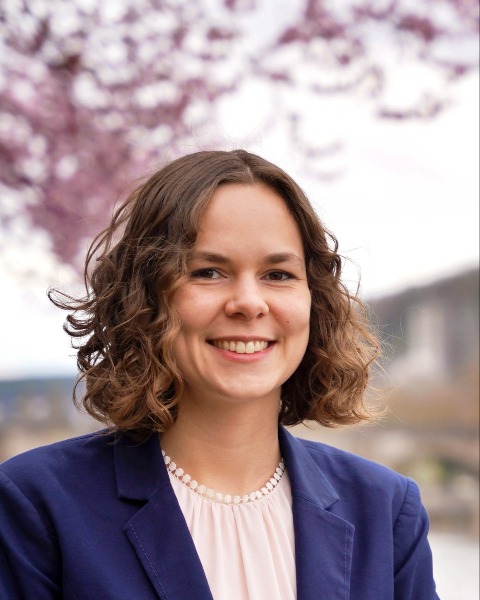Myeloma Microenvironment and immune profiling
Poster Session 3
P-406: Development of a 3D bioreactor model using a perfusion bioreactor to study osteocyte progenitor cells and the Involvement of single ECM molecules in Multiple Myeloma Bone Disease
Friday, September 29, 2023
1:15 PM - 2:15 PM EEST

Wyonna D. Rindt
PhD student
Department of Internal Medicine II, University Hospital Würzburg, Würzburg, Germany
Würzburg, Bayern, Germany
Introduction: Myeloma bone disease (MBD) is a hallmark of MM and affects 80% of MM patients. Current treatments do not fully regenerate osteolytic lesions, even in the absence of MM cells. We showed that tibial compressive loading prevents bone destruction, and reduces MM growth and dissemination in the MOPC315.BM mouse model. In this study, we established an in vitro 3D bioreactor model for MM to characterize the mechanobiological processes in osteocytes, the main mechanosensors controlling bone remodeling.
Methods: Osteocytic IDG-SW3 cells were seeded onto three different scaffolds: decellularized and partially demineralized dBone derived from human femoral heads, synthetic ß-tricalcium phosphate (ß-TCP), and synthetic poly(L-lactide-co-trimethylene carbonate) (LTMC). To assess the colonization efficiency under static and dynamic conditions in the bioreactor, viability, and growth of IDG-SW3 cells were evaluated by MTT, PicoGreen assay, and LIVE/DEAD staining. Osteocytic differentiation was confirmed by alkaline phosphatase (ALP) staining and gene expression analysis of alkaline phosphatase (Alpl), sclerostin (Sost), and dentin matrix protein 1 (Dmp-1). Biophysical stimulation was exerted by compressing the scaffolds with a movable arm. Expression of the mechanoresponsive genes FBJ osteosarcoma oncogene (Fos) and cyclooxygenase-2 (Cox2) was analyzed to determine the mechanoresponse.
Results: In all scaffolds, reproducible cell seeding capacity was detected with dBone scaffolds exhibiting donor variability. Homogeneous distribution and high density were achieved in dBone and LTMC scaffolds under static and dynamic conditions, whereas the cells colonized only on the top of the ß-TCP scaffolds and barely grew through after ten days. ß-TCP scaffolds demonstrated low mechanical loading capacity and disintegrated upon compression. We found that osteocytic differentiation was most efficiently induced under dynamic conditions, as evidenced by upregulation of the differentiation markers Alpl, Sost, Dmp-1, and by ALP staining. Fos and Cox2 were induced through mechanical loading of the LTMC scaffolds.
Conclusions: The established bioreactor system is suitable to study molecular changes in osteocytes caused by MM and mechanical loading. Differences in pore size, porosity, and interconnectivity of these scaffolds affect the growth and cell migration of IDG-SW3 cells. Since the ß-TCP scaffolds did not show a homogenous distribution of the cells with also insufficient mechanical stability and the dBones exhibited inter- and intra-donor variability, the LTMC scaffolds provided the most reliable results. We will use the bioreactor in future studies to characterize the molecular mechanisms of mechanotransduction in osteocytes in the presence of MM cells and their supernatant to evaluate whether secreted factors of MM cells affect the differentiation and function of osteocytes.
Methods: Osteocytic IDG-SW3 cells were seeded onto three different scaffolds: decellularized and partially demineralized dBone derived from human femoral heads, synthetic ß-tricalcium phosphate (ß-TCP), and synthetic poly(L-lactide-co-trimethylene carbonate) (LTMC). To assess the colonization efficiency under static and dynamic conditions in the bioreactor, viability, and growth of IDG-SW3 cells were evaluated by MTT, PicoGreen assay, and LIVE/DEAD staining. Osteocytic differentiation was confirmed by alkaline phosphatase (ALP) staining and gene expression analysis of alkaline phosphatase (Alpl), sclerostin (Sost), and dentin matrix protein 1 (Dmp-1). Biophysical stimulation was exerted by compressing the scaffolds with a movable arm. Expression of the mechanoresponsive genes FBJ osteosarcoma oncogene (Fos) and cyclooxygenase-2 (Cox2) was analyzed to determine the mechanoresponse.
Results: In all scaffolds, reproducible cell seeding capacity was detected with dBone scaffolds exhibiting donor variability. Homogeneous distribution and high density were achieved in dBone and LTMC scaffolds under static and dynamic conditions, whereas the cells colonized only on the top of the ß-TCP scaffolds and barely grew through after ten days. ß-TCP scaffolds demonstrated low mechanical loading capacity and disintegrated upon compression. We found that osteocytic differentiation was most efficiently induced under dynamic conditions, as evidenced by upregulation of the differentiation markers Alpl, Sost, Dmp-1, and by ALP staining. Fos and Cox2 were induced through mechanical loading of the LTMC scaffolds.
Conclusions: The established bioreactor system is suitable to study molecular changes in osteocytes caused by MM and mechanical loading. Differences in pore size, porosity, and interconnectivity of these scaffolds affect the growth and cell migration of IDG-SW3 cells. Since the ß-TCP scaffolds did not show a homogenous distribution of the cells with also insufficient mechanical stability and the dBones exhibited inter- and intra-donor variability, the LTMC scaffolds provided the most reliable results. We will use the bioreactor in future studies to characterize the molecular mechanisms of mechanotransduction in osteocytes in the presence of MM cells and their supernatant to evaluate whether secreted factors of MM cells affect the differentiation and function of osteocytes.
